coolant temperature Hyundai Genesis Coupe 2015 Owner's Manual
[x] Cancel search | Manufacturer: HYUNDAI, Model Year: 2015, Model line: Genesis Coupe, Model: Hyundai Genesis Coupe 2015Pages: 438, PDF Size: 40.35 MB
Page 129 of 438
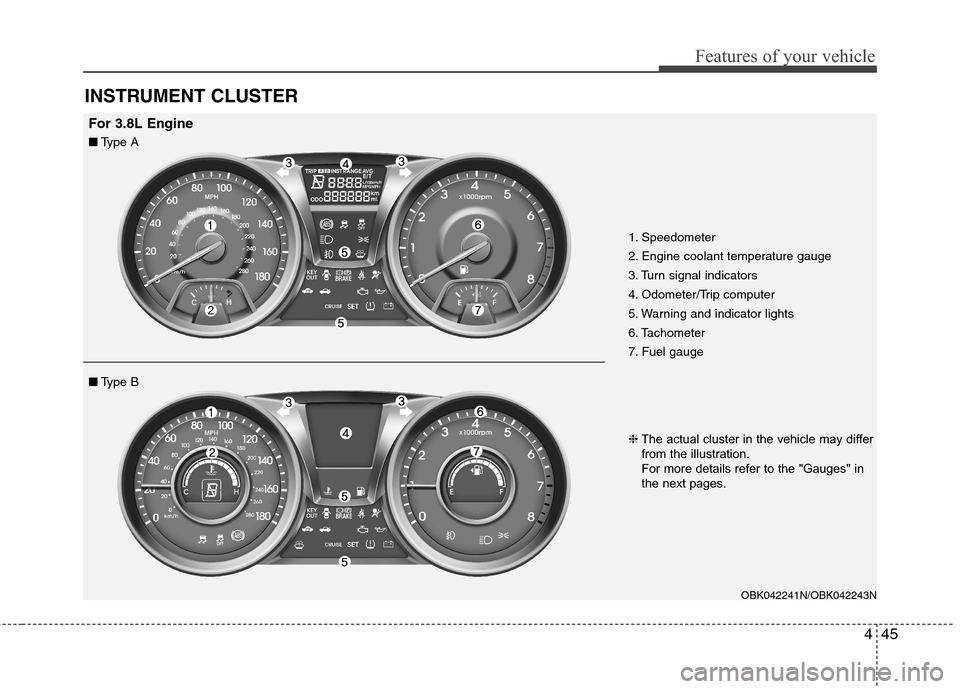
445
Features of your vehicle
INSTRUMENT CLUSTER
OBK042241N/OBK042243N
1. Speedometer
2. Engine coolant temperature gauge
3. Turn signal indicators
4. Odometer/Trip computer
5. Warning and indicator lights
6. Tachometer
7. Fuel gauge
■Type A
❈The actual cluster in the vehicle may differ
from the illustration.
For more details refer to the "Gauges" in
the next pages. ■Type B
For 3.8L Engine
Page 131 of 438
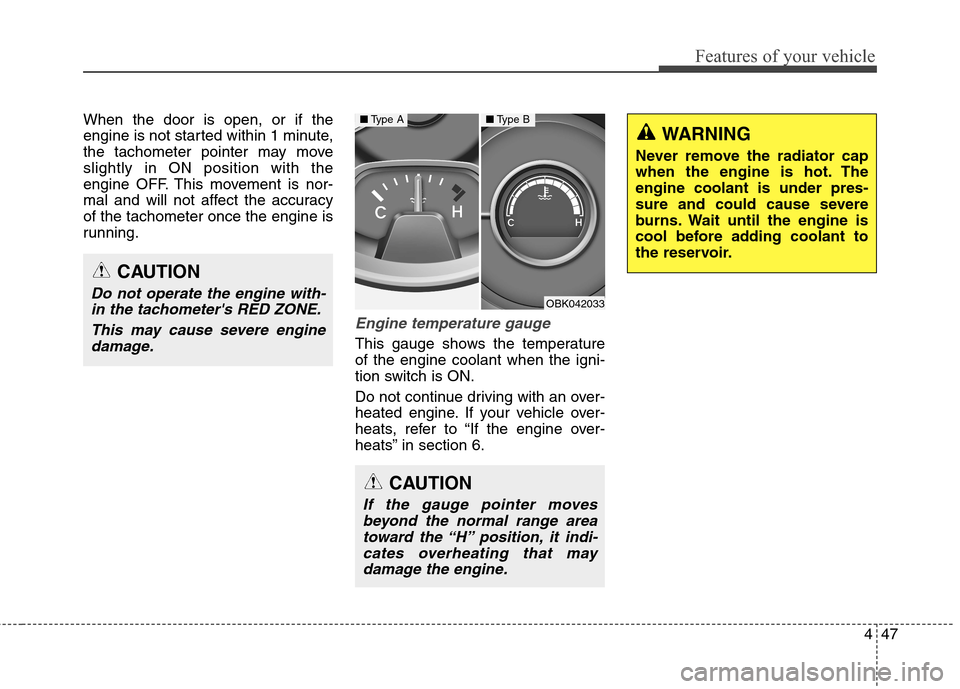
447
Features of your vehicle
When the door is open, or if the
engine is not started within 1 minute,
the tachometer pointer may move
slightly in ON position with the
engine OFF. This movement is nor-
mal and will not affect the accuracy
of the tachometer once the engine is
running.
Engine temperature gauge
This gauge shows the temperature
of the engine coolant when the igni-
tion switch is ON.
Do not continue driving with an over-
heated engine. If your vehicle over-
heats, refer to “If the engine over-
heats” in section 6.
CAUTION
Do not operate the engine with-
in the tachometer's RED ZONE.
This may cause severe engine
damage.
CAUTION
If the gauge pointer moves
beyond the normal range area
toward the “H” position, it indi-
cates overheating that may
damage the engine.
OBK042033
■Type A■Type B
WARNING
Never remove the radiator cap
when the engine is hot. The
engine coolant is under pres-
sure and could cause severe
burns. Wait until the engine is
cool before adding coolant to
the reservoir.
Page 151 of 438
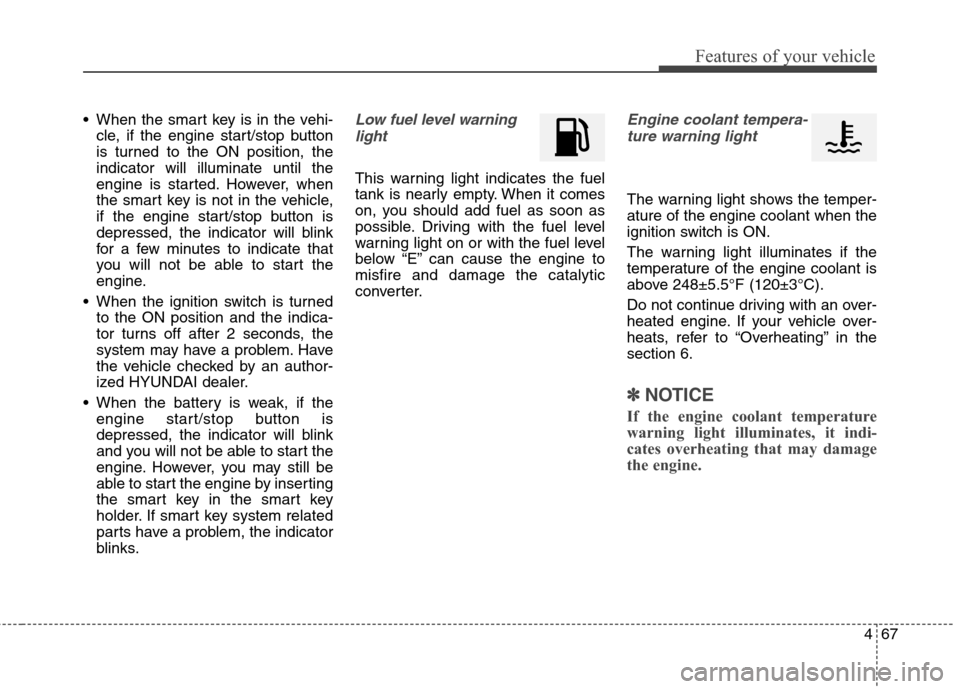
467
Features of your vehicle
When the smart key is in the vehi-
cle, if the engine start/stop button
is turned to the ON position, the
indicator will illuminate until the
engine is started. However, when
the smart key is not in the vehicle,
if the engine start/stop button is
depressed, the indicator will blink
for a few minutes to indicate that
you will not be able to start the
engine.
When the ignition switch is turned
to the ON position and the indica-
tor turns off after 2 seconds, the
system may have a problem. Have
the vehicle checked by an author-
ized HYUNDAI dealer.
When the battery is weak, if the
engine start/stop button is
depressed, the indicator will blink
and you will not be able to start the
engine. However, you may still be
able to start the engine by inserting
the smart key in the smart key
holder. If smart key system related
parts have a problem, the indicator
blinks.Low fuel level warning
light
This warning light indicates the fuel
tank is nearly empty. When it comes
on, you should add fuel as soon as
possible. Driving with the fuel level
warning light on or with the fuel level
below “E” can cause the engine to
misfire and damage the catalytic
converter.
Engine coolant tempera-
ture warning light
The warning light shows the temper-
ature of the engine coolant when the
ignition switch is ON.
The warning light illuminates if the
temperature of the engine coolant is
above 248±5.5°F (120±3°C).
Do not continue driving with an over-
heated engine. If your vehicle over-
heats, refer to “Overheating” in the
section 6.
✽ ✽
NOTICE
If the engine coolant temperature
warning light illuminates, it indi-
cates overheating that may damage
the engine.
Page 300 of 438
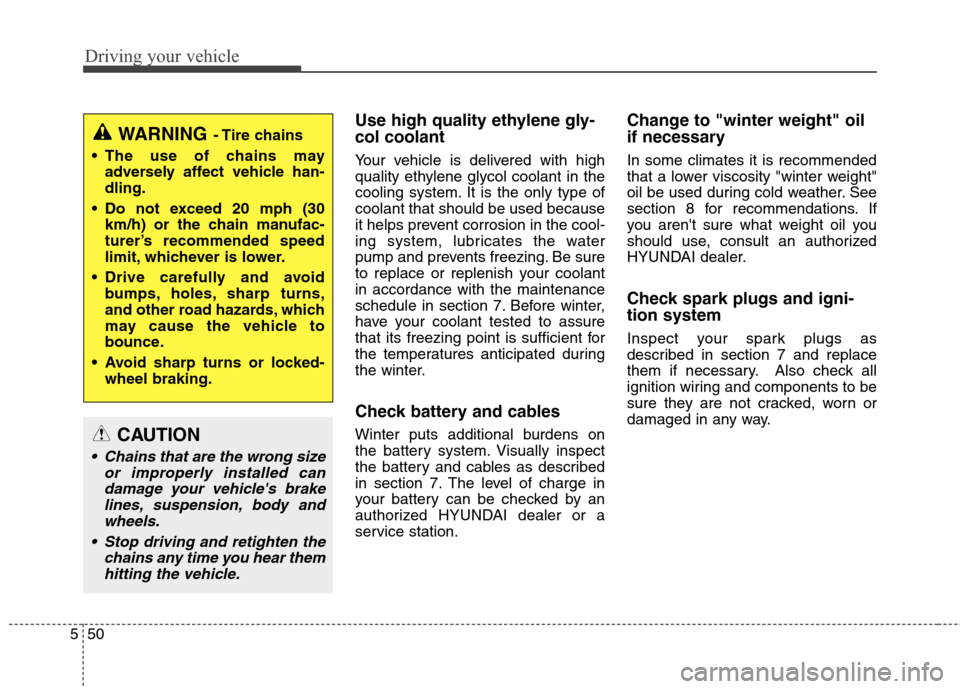
Driving your vehicle
50 5
Use high quality ethylene gly-
col coolant
Your vehicle is delivered with high
quality ethylene glycol coolant in the
cooling system. It is the only type of
coolant that should be used because
it helps prevent corrosion in the cool-
ing system, lubricates the water
pump and prevents freezing. Be sure
to replace or replenish your coolant
in accordance with the maintenance
schedule in section 7. Before winter,
have your coolant tested to assure
that its freezing point is sufficient for
the temperatures anticipated during
the winter.
Check battery and cables
Winter puts additional burdens on
the battery system. Visually inspect
the battery and cables as described
in section 7. The level of charge in
your battery can be checked by an
authorized HYUNDAI dealer or a
service station.
Change to "winter weight" oil
if necessary
In some climates it is recommended
that a lower viscosity "winter weight"
oil be used during cold weather. See
section 8 for recommendations. If
you aren't sure what weight oil you
should use, consult an authorized
HYUNDAI dealer.
Check spark plugs and igni-
tion system
Inspect your spark plugs as
described in section 7 and replace
them if necessary. Also check all
ignition wiring and components to be
sure they are not cracked, worn or
damaged in any way.
WARNING- Tire chains
The use of chains may
adversely affect vehicle han-
dling.
Do not exceed 20 mph (30
km/h) or the chain manufac-
turer’s recommended speed
limit, whichever is lower.
Drive carefully and avoid
bumps, holes, sharp turns,
and other road hazards, which
may cause the vehicle to
bounce.
Avoid sharp turns or locked-
wheel braking.
CAUTION
Chains that are the wrong size
or improperly installed can
damage your vehicle's brake
lines, suspension, body and
wheels.
Stop driving and retighten the
chains any time you hear them
hitting the vehicle.
Page 314 of 438
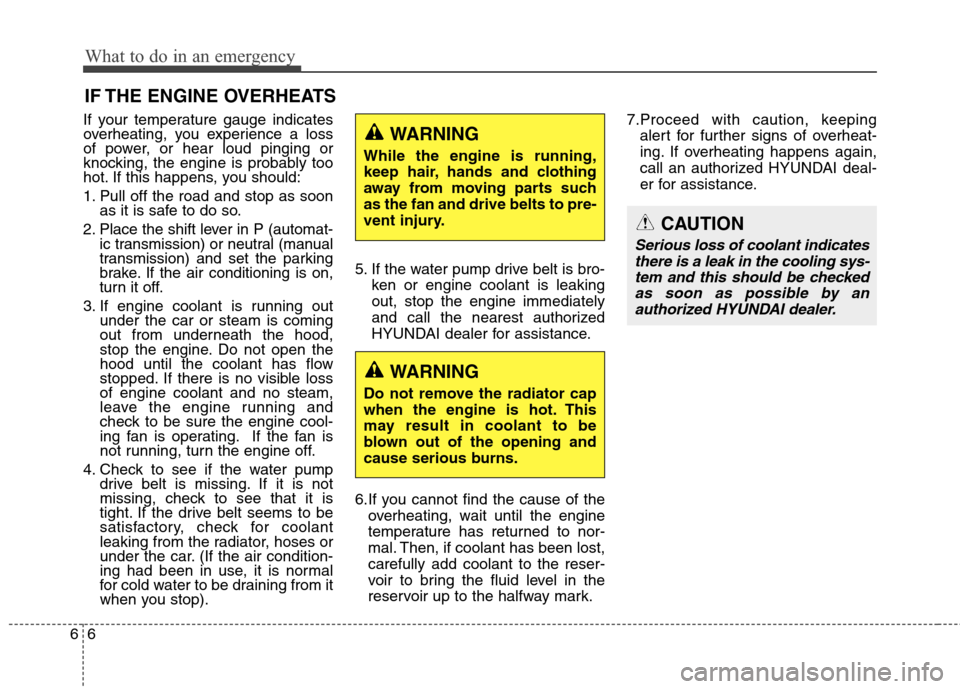
What to do in an emergency
6 6
IF THE ENGINE OVERHEATS
If your temperature gauge indicates
overheating, you experience a loss
of power, or hear loud pinging or
knocking, the engine is probably too
hot. If this happens, you should:
1. Pull off the road and stop as soon
as it is safe to do so.
2. Place the shift lever in P (automat-
ic transmission) or neutral (manual
transmission) and set the parking
brake. If the air conditioning is on,
turn it off.
3. If engine coolant is running out
under the car or steam is coming
out from underneath the hood,
stop the engine. Do not open the
hood until the coolant has flow
stopped. If there is no visible loss
of engine coolant and no steam,
leave the engine running and
check to be sure the engine cool-
ing fan is operating. If the fan is
not running, turn the engine off.
4. Check to see if the water pump
drive belt is missing. If it is not
missing, check to see that it is
tight. If the drive belt seems to be
satisfactory, check for coolant
leaking from the radiator, hoses or
under the car. (If the air condition-
ing had been in use, it is normal
for cold water to be draining from it
when you stop).5. If the water pump drive belt is bro-
ken or engine coolant is leaking
out, stop the engine immediately
and call the nearest authorized
HYUNDAI dealer for assistance.
6.If you cannot find the cause of the
overheating, wait until the engine
temperature has returned to nor-
mal. Then, if coolant has been lost,
carefully add coolant to the reser-
voir to bring the fluid level in the
reservoir up to the halfway mark.7.Proceed with caution, keeping
alert for further signs of overheat-
ing. If overheating happens again,
call an authorized HYUNDAI deal-
er for assistance.
WARNING
While the engine is running,
keep hair, hands and clothing
away from moving parts such
as the fan and drive belts to pre-
vent injury.
WARNING
Do not remove the radiator cap
when the engine is hot. This
may result in coolant to be
blown out of the opening and
cause serious burns.
CAUTION
Serious loss of coolant indicates
there is a leak in the cooling sys-
tem and this should be checked
as soon as possible by an
authorized HYUNDAI dealer.
Page 358 of 438
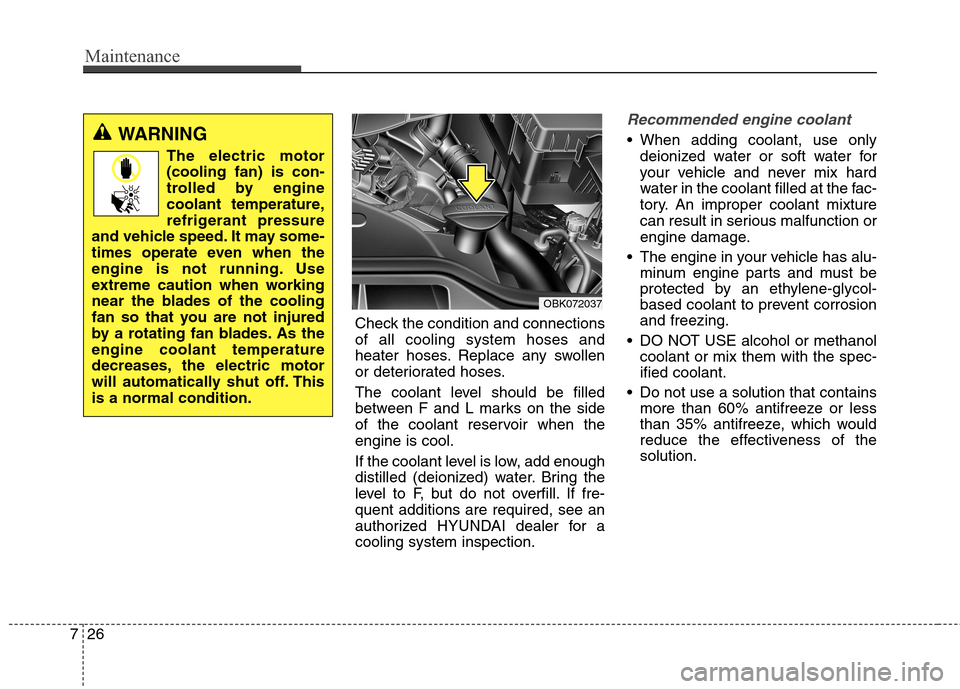
Maintenance
26 7
Check the condition and connections
of all cooling system hoses and
heater hoses. Replace any swollen
or deteriorated hoses.
The coolant level should be filled
between F and L marks on the side
of the coolant reservoir when the
engine is cool.
If the coolant level is low, add enough
distilled (deionized) water. Bring the
level to F, but do not overfill. If fre-
quent additions are required, see an
authorized HYUNDAI dealer for a
cooling system inspection.
Recommended engine coolant
When adding coolant, use only
deionized water or soft water for
your vehicle and never mix hard
water in the coolant filled at the fac-
tory. An improper coolant mixture
can result in serious malfunction or
engine damage.
The engine in your vehicle has alu-
minum engine parts and must be
protected by an ethylene-glycol-
based coolant to prevent corrosion
and freezing.
DO NOT USE alcohol or methanol
coolant or mix them with the spec-
ified coolant.
Do not use a solution that contains
more than 60% antifreeze or less
than 35% antifreeze, which would
reduce the effectiveness of the
solution.WARNING
The electric motor
(cooling fan) is con-
trolled by engine
coolant temperature,
refrigerant pressure
and vehicle speed. It may some-
times operate even when the
engine is not running. Use
extreme caution when working
near the blades of the cooling
fan so that you are not injured
by a rotating fan blades. As the
engine coolant temperature
decreases, the electric motor
will automatically shut off. This
is a normal condition.
OBK072037
Page 359 of 438
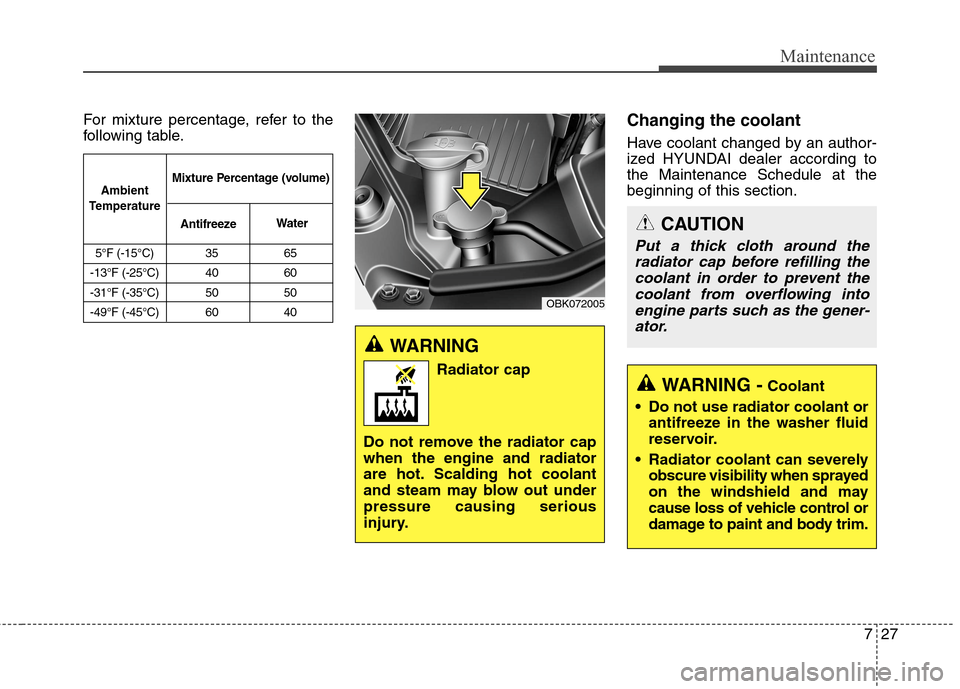
727
Maintenance
For mixture percentage, refer to the
following table.Changing the coolant
Have coolant changed by an author-
ized HYUNDAI dealer according to
the Maintenance Schedule at the
beginning of this section.
WARNING
Radiator cap
Do not remove the radiator cap
when the engine and radiator
are hot. Scalding hot coolant
and steam may blow out under
pressure causing serious
injury.
CAUTION
Put a thick cloth around the
radiator cap before refilling the
coolant in order to prevent the
coolant from overflowing into
engine parts such as the gener-
ator.
WARNING -Coolant
Do not use radiator coolant or
antifreeze in the washer fluid
reservoir.
Radiator coolant can severely
obscure visibility when sprayed
on the windshield and may
cause loss of vehicle control or
damage to paint and body trim.
5°F (-15°C) 35 65
-13°F (-25°C) 40 60
-31°F (-35°C) 50 50
-49°F (-45°C) 60 40
Ambient
TemperatureMixture Percentage (volume)
AntifreezeWater
OBK072005
Page 416 of 438

Maintenance
84 7
Canister
Fuel vapors generated inside the fuel
tank are absorbed and stored in the
onboard canister. When the engine is
running, the fuel vapors absorbed in
the canister are drawn into the surge
tank through the purge control sole-
noid valve.
Purge Control Solenoid Valve
(PCSV)
The purge control solenoid valve is
controlled by the Engine Control
Module (ECM); when the engine
coolant temperature is low during
idling, the PCSV closes so that evap-
orated fuel is not taken into the
engine. After the engine warms-up
during ordinary driving, the PCSV
opens to introduce evaporated fuel to
the engine.
3. Exhaust emission control
system
The Exhaust Emission Control
System is a highly effective system
which controls exhaust emissions
while maintaining good vehicle per-
formance.
Vehicle modifications
This vehicle should not be modified.
Modification of your vehicle could
affect its performance, safety or
durability and may even violate gov-
ernmental safety and emissions reg-
ulations.
In addition, damage or performance
problems resulting from any modifi-
cation may not be covered under
warranty.
If you use unauthorized electronic
devices, it may cause the vehicle to
operate abnormally, wire damage,
battery discharge and fire. For your
safety, do not use unauthorized
electronic devices.
Engine exhaust gas precautions
(carbon monoxide)
Carbon monoxide can be present
with other exhaust fumes.
Therefore, if you smell exhaust
fumes of any kind inside your vehi-
cle, have it inspected and repaired
immediately. If you ever suspect
exhaust fumes are coming into
your vehicle, drive it only with all
the windows fully open. Have your
vehicle checked and repaired
immediately.
Do not operate the engine in con-
fined or closed areas (such as
garages) any more than what is
necessary to move the vehicle in or
out of the area.
When the vehicle is stopped in an
open area for more than a short
time with the engine running,
adjust the ventilation system (as
needed) to draw outside air into the
vehicle.
Never sit in a parked or stopped
vehicle for any extended time with
the engine running.
Page 431 of 438

Index
4I
Defogging logic (Windshield)····························4-117
Defroster (Front window)
Front windshield deicer·································4-91
Defroster (Rear window)···································4-91
Defrosting (Windshield)···································4-114
Digital clock················································4-124
Dimensions·····················································8-2
Display illumination, see instrument panel illumination · · ·4-46
Displays, see instrument cluster···························4-45
Door locks····················································4-16
Central door lock switch································4-18
Speed sensing door lock system·······················4-19
Drinks holders, see cup holders··························4-122
Driver's 3-point seat belt····································3-18
Driver's and passenger's front air bag·····················3-48
Driving at night··············································5-44
Driving in flooded areas····································5-46
Driving in the rain···········································5-45
Driving off-road··············································5-46
DRL ···························································4-83
Economical operation·······································5-41
Electric chromic mirror (ECM)····························4-35
Electronic stability program (ESC)·······················5-31
Emergency fuel filler lid release···························4-29Emergency starting
Jump starting···············································6-4
Push starting················································6-5
Emergency while driving····································6-2
Emission control system····································7-83
Crankcase emission control system····················7-83
Evaporative emission control System·················7-83
Exhaust emission control system······················7-84
Engine compartment····································2-6, 7-3
Engine compartment fuse label····························7-60
Engine compartment panel fuse···························7-57
Engine coolant···············································7-25
Engine coolcant temperature gauge·······················4-47
Engine number················································8-7
Engine oil·····················································7-23
Engine overheats··············································6-6
Engine Specification··········································8-2
Engine start/stop button······································5-8
Engine will not start·········································
·6-3
Escort function···············································4-83
Evaporative emission control system·····················7-83
Exhaust emission control system··························7-84
Explanation of scheduled maintenance items···········7-20
Exterior care··················································7-76
Exterior overview (front)····································2-2
Exterior overview (rear)······································2-3
E
Page 432 of 438

I5
Index
Flat tire························································6-12
Jack and tools·············································6-12
Changing tires············································6-13
Removing and storing the spare tire···················6-13
Jack label··················································6-20
Floor mat anchor(s)········································4-125
Fluid
Automatic tranmission fluid····························7-30
Brakes/clutch fluid·······································7-28
Manual tranmission fluid································7-30
Power steering fluid······································7-29
Washer fluid···············································7-30
Folding the outside rearviwe mirror · · · · · · ················4-44
Folding the rear seat·········································3-13
Front seat adjustment (manual)·····························3-4
Front seat adjustment (Power)······························3-5
Front windshield deicer·····································4-92
Fuel additives··················································1-5
Fuel filler lid··················································4-27
Emergency fuel filler lid release·······················4-29
Fuel gauge····················································4-48
Fuel requirements·············································1-3
Alcohol and methanol·····································1-4
Fuel additives···············································1-5
Fuse switch···················································7-57Fuses···························································7-55
Engine compartment panel fuse························7-57
Fuse switch················································7-57
Fuse/relay panel description····························7-58
Instrument panel fuse····································7-55
Label·······················································7-58
Multi fuse··················································7-58
Gauge · · · · · · · · · · · · · · · · · · · · · · · · · ·································4-46
Engine coolant temperature gauge·····················4-47
Fuel gauge·················································4-48
Multi gauge···············································4-71
GAW (Gross axle weight)
··································5-57
GAWR (Gross axle weight rating)························5-57
Glass antenna···············································4-128
Glove box···················································4-120
Glove box lamp··············································4-90
GVW (Gross vehicle weight)······························5-57
GVWR (Gross vehicle weight rating)····················5-57
Hazard warning flasher································4-81, 6-2
Hazardous driving conditions······························5-43
Headlamp welcome function·······························4-82
F
G
H